March 22, 2013 – Volume 15, Issue 6
IN THIS ISSUE
Flanigan’s Eco-Logic
The Food Truck Fling
Mining Methane Hydrates
Zero-Emission Aviation
Sequestration: Part 1
Dye-Sensitized Solar Cells
Battery “U”
EcoMotion’s New Website

Flanigan’s Eco-Logic: The Second Half of Fuel Economy
Today I heard that the average car has 1.3 passengers, down from 1.8 or so a decade ago. Americans love driving solo, or at least they do so most of the time. This is not good for efficiency, the second half of fuel economy.
The first half is better fuel efficiency. It certainly makes sense with pump prices rising, Americans are finally taking MPG seriously. Why settle for 20 when you can buy 50 MPG for the same price, or less? At today’s prices – say $4.00 per gallon, and for the average 12,000 miles per year – that’s a savings of $1,440 per year.
Now the second half: How many passengers are on board, multiplying the value of the precious fuel being used? Plan trips and carpool. A passenger doubles the effective efficiency of your vehicle. (Sure, there is a 1 – 2% penalty for the increased weight.) Take two and triple the efficiency! Four…you get it. We need to think of efficiency in terms of consumption per unit distance per passenger, or what is known as “passenger-MPG.” It’s an easy way for compact hybrid drivers to break the century mark.
My friend Ralph Torrie puts buses in perspective. Without passengers, they are not particularly efficient. Diesel buses typically get about 6 miles per gallon. (Older buses get 4 MPG.) Two passengers turn the “passenger-MPG” to 12. You need at least eight passengers to rival the efficiency of an Insight or Prius. But a fully-loaded, 55-passenger bus in Santa Barbara has a P-MPG of 330. In 2011, Lisbon, Portugal reports a 20.1 average bus occupancy rate… a P-MPG of 180. (Another common means of comparing transit options is BTUs per revenue passenger mile.)
Then there’s a third half. What if time is factored in? A 747 gets 0.2 MPG. But if it is 75% full of passengers, the passenger MPG climbs to 30 P-MPG. If time is factored in, passenger miles per gallon per hour, the outcome is different. For instance, a Prius with two passengers going cross country at 50 mph will take 60 hours to do so. With a P-MPG of 50 x 2 = 100, its P-MPG/HR is 1.67. The 747 takes six hours for the same trip. Its P-MPG of 30 translates into a time efficiency of 5, 2.5 times that of the Prius. Inversely, a cruise ship gets 7 P-MPG. Given a thousand mile trip over a week (24 x 7 = 168 hours), its P-MPG/HR drops to 0.042. But cruising ain’t about passenger, fuel, and time efficiency!
Quote of the Week
“It’s like driving a block down the road.”
– The Rolling Stove Food Truck Driver
The Food Truck Fling

Food trucks in Los Angeles during a busy lunch hour
Are we still obsessed by the car culture?
Drive-ins, drive-thrus, convertibles, and now food trucks.
The rise of food trucks and the mobile food industry. Dig it. “Hang Ten Tacos,” “Cod Save the Queen,” and the “Vegitup Truck.” Considered roach coaches for years, they are now the rage, universally accepted as cool. Sheepishly I admit that I am little conflicted having spent years advocating mass transit and walkable communities. Do these fit into your vision of an efficient future?
Some love “Curbside Cupcakes.” Food trucks are featured at events. Jerk pork sandwiches and fried green tomatoes in Florida. Street-food favorites.
Enthusiasts like me huddle curbside in the cold, oft dim lighting, and filth to buy scrumptious, and now a bit expensive, gourmet finger foods. Crazy about my eggplant pocket in Cambridge, and those sweet potato fries at a TreePeople event. Ouch. So good. Trucks specialize in the mouthwatering.
But gotta ask the question: Are food trucks the RVs of restaurants? If so, how cool is that?
Many eco-folks criticize RVs for their fuel inefficiency. Food trucks are the same. “The Rolling Stove” gets 4 – 5 miles per gallon and is “being hammered by gasoline prices.” The owner claims that his truck is “completely non-aerodynamic. It’s like driving a block down the road.” And he can’t do more than 50 MPH. Many food trucks also use gasoline to run generators when parked.
Back to RVs? Why take your living room on the road? Why not support local economies by staying at inns and bed and breakfasts? Does it really make sense to wheel restaurants around? Hmmm… Does bringing the kitchen to the people make sense, or is there a net energy benefit in bringing the people to the kitchen? Depends no doubt. There’s an app in LA that tracks food trucks’ locations, so the people may be driving to the trucks too. Similarly, people drive distances to restaurants of choice, or to meet friends.
Gotta’ love the “white-hot food truck industry,” and gotta’ celebrate progress on all fronts: In late February, New York City Mayor Bloomberg welcomed New York’s first eco-friendly food truck to the City, a truck that runs on compressed natural gas and that bakes pizza on board in 90 seconds.
What else can be done to green food trucking? Mobile Cuisine Magazine, “the complete online resource for the mobile food industry,” presents seven fuel saving tips for operators, from driving habits, to route planning, and routine maintenance. There’s even a dummies book: “Running a Food Truck for Dummies.” Food truck consultants boast that they can save operators enough money to travel further to outlying areas. Hmmm.
That said, restaurants are also energy intensive. They require lots of lighting and ventilation both in the kitchen and dining area. While there is great variation, they tend to be open long hours, for multiple meals, and serve a wide variety of menu options. So many restaurants no doubt use more energy per meal served that many food trucks. But that’s before the drive.
And there is another big variable: What’s cooking? Food trucks’ on-board energy use varies widely: Some cook or bake at a restaurant or warehouse location, then deliver and sell via food trucks. Others cook, or blend, or bake, or juice, fry, chop, on board. Heavy grills roam the streets.
A eco-food truck web site lays out parameters for really cool, locally farmed, organic food, fair trade products; trucks that use biodiesel for mobility, propane for cooking, and solar power; provide compostable packaging and utensils; and that certainly don’t idle. A website tracks eco-friendly trucks, a search engine of sorts. I read of a truck that “conquered the streets of LA for three years,” now with “its first brick and mortar.”
Mining Methane Hydrates
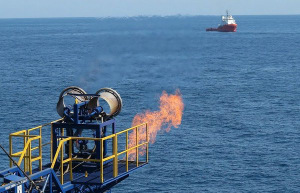
Waste gas flaring above the Pacific Ocean
Big news. The Japanese have reportedly successfully mined methane hydrates 50 miles offshore in the Sea of Japan in the Nankai Trough. This is potentially really good news for Japan: It’s been two years since the earthquake that crippled its Fukushima nuclear power plant. The country has no traditional fossil fuels and is looking at importing more oil and gas to balance its reduction in nuclear power.
Methane hydrates may represent a new and exciting source of energy. A form of “clathrates,” they are a “frozen cage of molecules” of methane and water sometimes known as “burnable ice” or “solid natural gas.”
Clathrates are at the nexus of chemistry and geology. Methane hydrates are found in both terrestrial and marine applications. They are hosted in sediments, within and beneath permafrost. Marine hydrates are potentially very important, but costly to recover. Canada had research successes in 2007 and 2008 but abandoned efforts due to cost.
A chemist first experimented with this class of compounds in Cornwall, England in the 1820s. Each clathrate is a guest compound locked inside the lattice structure of a host. They were a laboratory curiosity. Later they were a nuisance, clogging natural gas pipelines.
In the 1960s, “solid natural gas” was found in the Messoyakuka gas field in western Siberia, the first time it was found in a naturally occurring state. In 2003, researchers found methane hydrates 15 miles off the California coast, in the Santa Monica basin. They were found near the summit of an 800 meter undersea volcano.
Japanese proponents now hope to commercialize the technology by 2018. And the promise of large quantities is alluring. Scientists are using a depressurization method to transform the hydrates into methane gas. Japanese researchers believe there is at least a decade’s worth of natural gas for Japan in the deposit.
But there are concerns about these laboratory phenomena: No one knows how much of it there is. What if there are large releases and the “disassociation” of the methane from its crystalline form? This could trigger undersea landslides. Given methane’s high global warming potential (21 times that of carbon dioxide), a release triggered by change of temperatures or a change of pressure could cause abrupt climate change events. Methane hydrates are an unknown variable in the carbon equation.
Zero Emission Aviation
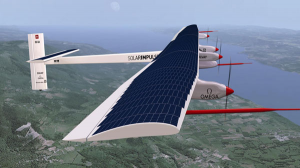
Solar powered plane takes flight
This spring, another record in flight will be attempted: The “Solar Impulse” will attempt a transcontinental flight from San Francisco to New York using zero liquid fuels. Instead, 11,628 solar cells create a wing span as long as a 747, to power the aircraft.
The Solar Impulse weighs as much as a car, but has the power of an average scooter. It’s a privately funded, $140 million, 12-year project. Its founders circumnavigated the earth in a balloon, then decided to go solar. Already they hold the record for the first intercontinental flight when they flew Solar Impulse from Morocco to Switzerland and back. In 2010, they flew the first solar-powered night flight, flying 26 consecutive hours.

Cheers for a successful test flight!
The project has already had commercial spinoffs, for instance special carbon-fiber tubing developed for the ultra-light plane. One of the project goals is “to inspire people to achieve things that initially may appear impossible.” According to co-founder Bertrand Piccard, its investors “must have a pioneering spirit.”
Sequestration Part I
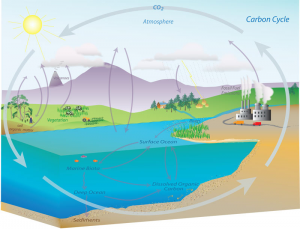 Sequestration is the capture and long-term storage of atmospheric carbon dioxide, CO2 removal, an important form of geo-engineering. There are several forms of sequestration: oceanic, geologic, and terrestrial. Sequestration occurs above ground in leaves, stems and trunks of trees; in long-lived products such as wood to make houses; and in soil – northern forests store twice the carbon in the soil as they do above ground; and in rocks that tie up carbon for years.
Sequestration is the capture and long-term storage of atmospheric carbon dioxide, CO2 removal, an important form of geo-engineering. There are several forms of sequestration: oceanic, geologic, and terrestrial. Sequestration occurs above ground in leaves, stems and trunks of trees; in long-lived products such as wood to make houses; and in soil – northern forests store twice the carbon in the soil as they do above ground; and in rocks that tie up carbon for years.
Bio-sequestration is about natural processes. Then there’s “carbon capture and storage,” stripping CO2 from flues of power plants and industries and then injecting it into salt caverns and other underground repositories. A coal plant in North Dakota became the nation’s first to capture carbon emissions from flue gases in 2000. The oil industry has been injecting CO2 in wells for enhanced oil recovery for years.
Let’s get back to basics. There’s a lot of sequestration taking place without fanfare every day. Geologic sequestration is the least obvious, where CO2 is stored in the pores of geologic formations. Even it can be manipulated through hydrodynamic, solubility, and mineral carbonation “trapping.” Oceans are the biggest CO2 sinks. Then there’s terrestrial sequestration, when carbon is stored in plants, animals, and soils. Imagine peat bogs. To be effective biomass sinks, trees and forests must grow in perpetuity.

Trees are part of the carbon sequestration solution
Every year, American trees capture an enormous amount of CO2, one estimate is 310 million metric tons of carbon dioxide each year. Others say 200 – 300 million tonnes annually. That’s about 5% of the national footprint. While the value is imprecise, forests certainly provide an “enormous ecosystem service.”
Note that a small percentage of this “sink” is lost annually. Every year, about 0.9% of American forests burn in forest fires. The year 2006 was unusually bad, 1.3% of the forest cover burned.
Dye-Sensitized Solar Cells
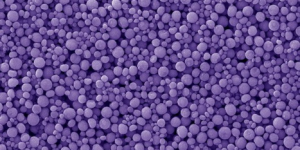
Dye-sensitized cells with a popcorn-ball design
In the 1960s scientists at the Swiss Federal Institute of Technology in Lausanne, and other institutions, discovered that illuminated organic dyes can generate electricity from sunlight. This is based on the semiconductor formed between a photosensitized anode and an electrolyte, a photo-electro-chemical system. Dye sensitized solar cells, instead of using silicon to absorb sunlight like conventional photovoltaic panels, use dye molecules attached to particles of titanium dioxide pigment used in paints. The electrons “hop” from the dye to a layer of electrolyte.
The first modern version of the film was developed at UC Berkeley in 1988. Its benefits are that it is semi-transparent and semi-flexible. The solar cells are built up in several layers. First, a barrier of normal paint is laid directly on the steel, then the electrolyte and dye layers, and finally a clear protective film to guard against the elements.
Dye-sensitized solar cells (DSSC) are now being commercially developed with overall conversion efficiencies averaging 11%, the upper end of the thin film solar cells. For comparison, low-cost crystalline panels have efficiencies of 12 – 15%.
The technology has great potential for building shell applications, potentially extending the life of metal cladding. The Swansea Consortium in United Kingdom is developing technology to paint solar cells onto steel cladding for buildings. The cladding is currently painted in steel mills passing through a spray booth on rollers. The research team is working toward a goal of spraying on 40 square meters a minute.
Commercialization is underway and Dyesol is a leading player. It was formed in 2004 and has forged research partnerships with leading institutions around the world. It is collaborating with Tata Steel Europe for roof sheeting, and in a joint venture with Timo Technologies in Korea, supplying windows for a sustainable office building at Seoul City’s Human Resources Development Centre Office Complex. There may be a bright future for this young technology.
Battery “U”
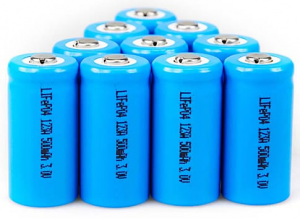
Batteries are essential for reliable and portable power
Battery “University” will begin operations this summer, ready to educate a specialty workforce in the rapidly growing batter industry. Battery “U” was made possible through a partnership between CalCharge and San Jose State University.
CalCharge, “an energy storage innovation accelerator,” is guided by a group of nonprofit organizations working to accelerate the movement of clean energy technologies, and the Lawrence Berkeley National Laboratory.
The battery classes will be provided through San Jose State University which boasts that it produces more engineering professionals for the Silicon Valley than any other university. Area scientists, entrepreneurs, industry and policy experts have met to give feedback on the Battery “U” vision and planned curriculum.
While most battery manufacturing currently takes place in China, there are at least 40 battery-related companies in California working to solve energy storage challenges. This technology is critical to market adoption of electric vehicle sectors, and to shoring up the value of intermittent renewable power generation such as solar and wind.
Thanks to Hifinit for Webworks

The EcoMotion team wholeheartedly thanks Hifinit of Brookline, Massachusetts for redesigning our website. Hats off to Alex and Geoff. Thanks to EcoMotion’s Cambridge-based Campus Services team which led the effort, the new website is up-to-date and live!
Check it out: www.EcoMotion.us
Hifinit Design Group was founded by Alex Turnwall, a professor of graphic design at Northeastern University, and Geoff House, a talented graduate. They listen and shape. While clarifying EcoMotion’s services and accomplishments, they revamped our look, including a logo enhancement. Thanks Alex and Geoff. We recommend them.
